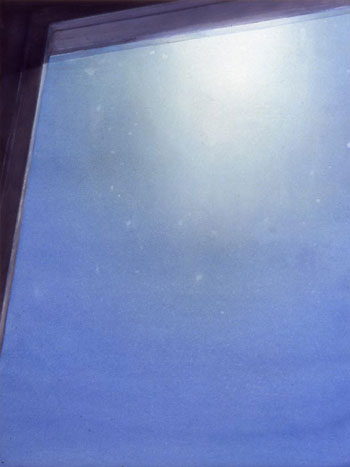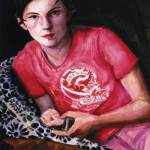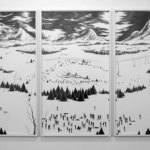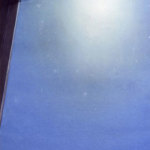Disliking the Whitney Biennial is nowadays a very common attitude and, for a critic, always a safer opinion. The prevalent argument against this biennial is actually justified: the curatorial will is hard to catch since it generally ends up diluted in the accumulation of a hundred-or-so diverse works that are supposed to survey two years of American visual arts. Since the search for a definition of today’s “American art” could fill many books, I’ll leave this job to competent scholars and will rather focus on the quality of this 2004 Whitney Biennial. Even though I could hardly remember half of the works without the help of the catalogue and couldn’t really connect to some parts of the show, I’ll stand by a true love of this edition of the Whitney Biennial. This for at least two essential reasons: the articulation of the exhibition relies on relevant curatorial concerns; and the selection of artists and works, although it covers a broad range of practices and strategies, leaves very little room to mediocrity or self indulgence.
A legitimate question that awaited the opening was: “What will be the impact and visibility of politics through the show?” At such a controversial and critical moment in American history, this Whitney Biennial couldn’t afford to avoid the topic. A part of the answer lies in the first paragraph of a 1970 Robert Smithson text published in the catalogue: “The artist does not have to will a response to the ‘deepening political crisis in America.’ Sooner or later the artist is implicated or devoured by politics without even trying.” The quotation of Smithson is less an escapatory subterfuge than a kickoff for the “intergenerational conversation” that is one of the vectors of the show. The curators actually emphasized the relations of today’s visual art with that of the late '60s and early '70s, i.e. another controversial war time: the Vietnam era. Recurrent references to the art of this period are not that surprising since this is the historic time when most of the forms that still fuel contemporary art emerged. This was also the time of the last subversive avant-gardes and of the affirmation of a counterculture based on political activism. Many artists who got recognition then and have since gained an historic status, are represented in the biennial: Marina Abramovic, Mel Bochner, Stan Brakhage, David Hockney and Yayoi Kusama, among others.
Interestingly, they are featured alongside young artists who now capitalize on conceptual art, minimalism and postminimalism but often recycle these forms into an all new meaning. Often, strategies that were originally very formalist end up now to be reinterpreted and charged with additional elements and even personal feelings. Dike Blair’s geometric assemblages of fluorescent lights, carpet and glass could appear simply minimalist and formalist if they weren’t also the support for photographs. In addition, Blair’s corpus of work also includes watercolors of flowers.
Along with this ‘60s and ‘70s inheritance, curators identified another common affliction among today’s artists: nostalgia. In her contribution to the catalogue, curator Debra Singer teaches us that, at the end of the 17th century, nostalgia was “thought to be a physical illness that afflicted soldiers posted far from home.” It is a matter of fact that many of the artists in this exhibition seem to struggle with dark thoughts. Anyone wandering through the biennial, especially on the 4th floor of the museum, is given a chance to experience the kind of feeling that passengers of the Titanic probably had. Even Raymond Pettibon’s commissioned drawings, installed all over a room and referring to the current political situation, reveal an unusually gloomy facet of his work.
As for many younger artists, nostalgia happens to be expressed through a mix of glam and goth aesthetics. “Christian Holstad, Terence Koh, and David Altmejd, among others, writes Debra Singer, pair sensibilities of psychedelia, kitsch, and camp with aspects of nineteenth-century Romantic ideas of the gothic relating to an interest in horror, morbidity, and eroticism as a way to access the sublime.”
Also, some thirty years after Robert Crumb and real life hero Harvey Pekar started the trend, the 2004 Whitney Biennial seems to celebrate the permanence of the outcast nerd, an iconic figure of American counterculture. A short history of nerdy drawing and painting is actually visible through new works by David Hockney, Elizabeth Peyton and Zak Smith, who illustrated each of the pages of Thomas Pynchon’s cult novel Gravity’s Rainbow. Even more pictorial works –like Robyn O’Neil’s uncanny landscapes— are revelatory of a number of artists’ retreat into fantasy or inner worlds. But magnificent outcast nerds are primarily represented here by Terence Koh, formerly better known as Asian Punk Boy. His piece --like Kusama’s-- requires the isolation of the viewer in a closed small room covered in a mysterious white powder that obviously refers to drugs but also loneliness, melancholy and all the beautiful decadent spirit that he shows in his web-based diary: asian punk boy.
- Elizabeth Peyton; Live to Ride (E.P.), 2003; Oil on board; Courtesy of Whitney Museum of American Art.
- Robyn O’Neil; Everything that stands will be at odds with its neighbor, and everything that falls will perish without grace. 2003; Graphite on paper; 94 ½ x 162 ½ in.; Image courtesy of Artpace, San Antonio, TX.
- Dike Blair; Untitled, 2002; Gouache and pencil on paper; 24in. x 18 in. Image courtesy of the http://www.thing.net/~lilyvac/ .
Links:
Whitney Museum
Whitecubes.org
The "Whitney Biennial" is on view through May 30th at the Whitney Museum of American Art.
All images are courtesy of the artists, their galleries and the Whitney Museum of American Art.
Christophe Perez is founding editor of Whitecubes.org (a web-based portal to Boston's contemporary art scene) with April Julich. A journalist and art critic, he covers East Coast art exhibitions for the French monthly art magazine L'Oeil and the UK monthly Contemporary.







